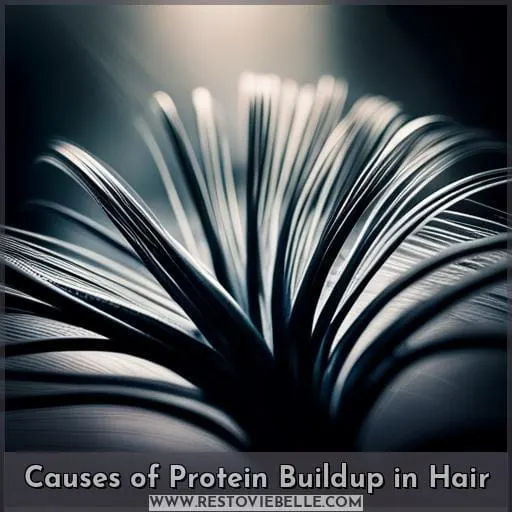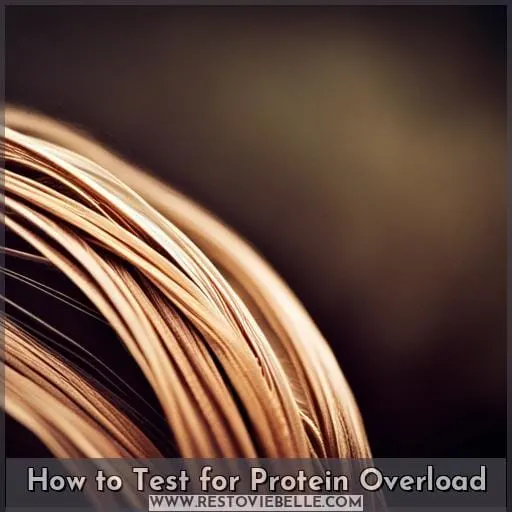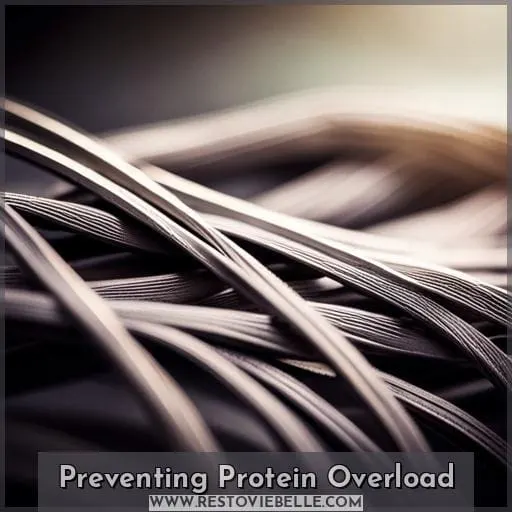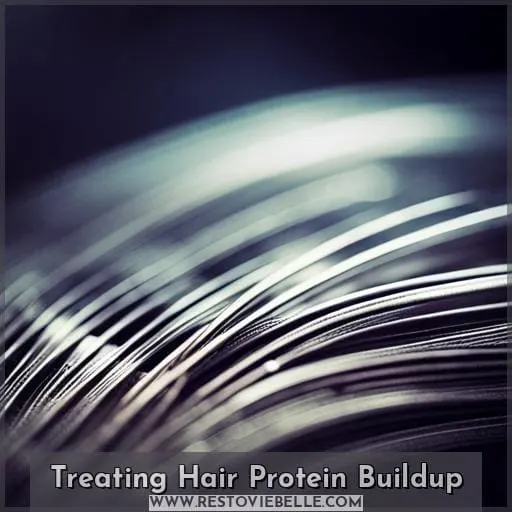This site is supported by our readers. We may earn a commission, at no cost to you, if you purchase through links.
 If you’re struggling with lackluster hair and wondering why it doesn’t feel as healthy as it used to, product buildup could be the culprit.
If you’re struggling with lackluster hair and wondering why it doesn’t feel as healthy as it used to, product buildup could be the culprit.
In this article, we’ll show you how to determine if your hair has excess product buildup and provide essential tips on how to treat it effectively. By understanding the signs of protein overload and making necessary adjustments in your hair care routine, you can regain control over your locks and achieve healthier, more vibrant hair.
Table Of Contents
- Key Takeaways
- Signs of Protein Buildup
- Causes of Protein Buildup in Hair
- How to Test for Protein Overload
- Preventing Protein Overload
- Treating Hair Protein Buildup
- Frequently Asked Questions (FAQs)
- Can product buildup make my hair feel crunchy and stiff?
- Are there any natural oils that can contribute to protein buildup in hair?
- How long does it typically take for hair to recover from protein overload?
- Can I still use protein treatments if I have protein buildup in my hair?
- Are there any specific hair care products that can help prevent protein overload?
- Conclusion
Key Takeaways
- Dry, dull, and brittle hair
- Loss of curl definition
- Coarse texture
- Split ends and breakage
Signs of Protein Buildup
If you’ve noticed that your hair feels dry, dull, and brittle, it may be a sign of protein buildup.
Additionally, if you’re struggling to hold curls or experiencing split ends and breakage more frequently than usual, these could also indicate an excess of protein in your hair.
It’s important to pay attention to these signs as they can help guide your hair care routine and prevent further damage.
Dry, Dull, and Brittle Hair
If your hair feels dry, dull, and brittle, it may be a sign of protein buildup. This can make curls lose definition and hair feel:
- Lifeless
- Brittle
- Straw-like
- Prone to tangling
Seeking protein-free deep conditioning and focusing on moisture balance helps restore vibrancy.
Coarse Texture and Difficulty Holding Curls
Your curls losing definition and having a coarse or straw-like texture points to excessive protein in your strands, which alters curl pattern and makes styling more difficult.
Rebalance moisture levels with a clarifying wash and protein-free deep conditioning to restore softness and springy ringlets.
Evaluate product ingredients and transition to alternatives lacking proteins.
Split Ends, Breakage, and Increased Shedding
You’ll notice split ends, breakage, and increased shedding if your hair has too much protein buildup. This overload prevents moisture retention, causing brittle strands prone to snapping.
Clarifying shampoos remove buildup while protein-free conditioners provide needed hydration.
Targeted solutions address shedding and improve texture by balancing protein with nourishing ingredients.
Monitoring hair closely allows customized adjustments, restoring strength and preventing further damage from protein overload.
Causes of Protein Buildup in Hair
You may be wondering what leads to excessive protein accumulating in your hair.
Overusing protein-containing products without properly balancing moisture, applying too many protein treatments, and lacking hydration are the main culprits that cause buildup.
This overload creates a barrier that prevents your hair from properly absorbing the moisture it desperately needs.
Overuse of Protein-containing Products
Using too many products containing protein can cause buildup in your hair. Protein sensitivity varies from person to person, and excessive use of these products may disrupt the delicate balance between protein and moisture in your strands.
To prevent or recover from protein overload, it’s important to prioritize moisture management through recovery strategies such as adjusting product alternatives and incorporating proper environmental impact considerations into your routine.
Lack of Balance Between Protein and Moisture
When not pairing protein treatments with adequate moisture, you’re at risk for protein overload. Achieving a balance between protein and moisture is crucial for maintaining healthy hair.
To prevent protein buildup, incorporate effective moisture strategies and hydration techniques into your routine.
Opt for deep conditioning alternatives that are free of proteins to avoid further exacerbating the issue.
Additionally, be mindful of environmental impacts on your hair and adjust your regimen accordingly to ensure proper recovery timelines.
Excessive Protein Treatments
One cause of protein buildup in hair is overusing protein treatments.
Frequent protein treatments can overload hair for those with protein sensitivity.
Recovery strategies involve clarifying shampoos to remove buildup and deep conditioning to add moisture.
Environmental factors like humidity can impact protein overload, requiring adjustments to hair care routines.
Maintaining moisture through conditioners and styling products is key to balance excess protein.
How to Test for Protein Overload
To determine if your hair has protein overload, you can conduct a simple protein treatment test.
- Apply a small amount of protein-based product to a section of your hair.
- Observe how it reacts over the next few days.
Additionally, monitoring changes in hair texture and condition can also indicate if you have too much protein buildup.
Conducting a Protein Treatment Test
You can conduct a protein treatment test to differentiate protein overload from other types of damage.
- Apply a protein treatment to a small section of hair.
- Evaluate the results after 48 hours.
- Look for signs of improved elasticity and minimized breakage, indicating that more protein is needed.
- If your hair worsens with increased dryness or brittleness, excess protein is likely the issue.
Adjust your hair care routine based on these findings for personalized, effective care that balances moisture versus proteinsensitivity recovery timelines while considering environmental impact factors like sulfate-free shampoo usage.
Additional Information:
- Protein sensitivity refers to an individual’s unique response to proteins in their hair products.
- Recovery timelines vary depending on the severity of the protein overload and how well one follows adjusted routines.
- Environmental impact includes factors like humidity levels or exposure to excessive heat or cold temperatures.
- Customized Haircare involves tailoring routines based on specific needs such as balancing moisture and proteinsensitivity levels adequately.
-Moisture vs.Protein: Finding balance between maintaining proper hydration (moisture) without overloading with too much external strength (protein).
Monitoring Hair Texture and Condition
To monitor for protein overload, pay attention to changes in your hair’s texture and condition.
- Assess the overall feel of your hair by running your fingers through it.
- Look out for signs of dryness, brittleness, and a lack of elasticity.
- If you notice that your hair feels rough or straw-like, it could be an indication of protein buildup.
Additionally, observe how well your hair retains moisture after moisturizing treatments.
- If hydration strategies seem ineffective and your hair remains dry even after deep conditioning or using a hydrating mask, it may be time to address potential protein overload as the culprit behind these issues.
Preventing Protein Overload
To prevent protein overload and maintain healthy hair, it’s important to use protein treatments sparingly.
Balancing these treatments with moisturizing products will help keep your hair in optimal condition.
Additionally, individualizing your hair care routine based on your specific needs and listening to how your hair responds will ensure that you’re giving it the right balance of nutrients.
Using Protein Treatments Sparingly
After testing for protein overload, you shouldn’t overdo protein treatments.
Use them sparingly, following product instructions.
Consider your hair’s protein sensitivity and individualize your routine based on its response.
Balance treatments with moisturizers or alternative treatments.
Monitor hair texture changes to adapt your regimen to environmental stressors.
Consult a professional if unsure how to adjust your cleansing routine.
Balancing Protein Treatments With Moisturizing Products
Balancing your protein treatments with moisturizing products can prevent protein overload.
To maintain a healthy balance, incorporate moisturizing techniques into your hair care routine.
Look for protein-free alternatives that contain nourishing and hydrating ingredients to replenish moisture in the hair.
Customized haircare is key to finding the right balance for your specific needs.
Consider adjusting your routine based on weather impact and recovery timelines, using protein sparingly while incorporating plenty of moisturizing ingredients to keep your locks vibrant and healthy.
Individualizing Hair Care Routine
When customizing your hair care routine to prevent protein overload, it’s important to tailor it specifically for your hair type and needs.
Evaluate your hair’s texture and porosity to determine ideal moisture levels.
Seek personalized products that provide customized hydration without excessive protein.
Experiment with individualized treatments until finding an optimal balance of tailored moisturizers and treatments.
This personalized haircare approach prevents overload while optimizing hair health.
Treating Hair Protein Buildup
If you notice the telltale signs of protein overload, it’s time to adjust your hair care routine.
Changing up your wash day,
Incorporating clarifying shampoos,
Deeply moisturizing your hair,
And avoiding protein products for a time can help restore balance and bounce.
Pivoting your regimen based on environmental factors is also key to preventing future buildup issues.
Changing Wash Day Routine With Clarifying Shampoo
You’ll want to start using a clarifying shampoo regularly to remove buildup and rebalance hair.
Clarifying shampoos have numerous benefits for your strands, including removing product buildup, excess oils, and impurities.
It’s recommended to incorporate a clarifying shampoo every few wash days or at least once a month depending on your individual needs.
Alternate between the clarifying shampoo and your regular sulfate-free shampoo for an effective cleansing routine that prevents damage from product buildup.
Adjusting your wash day routine with a clarifying shampoo can help maintain healthy, vibrant hair throughout the seasons while preventing further damage from protein buildup in damaged strands.
Moisturizing Hair to Restore Balance
Your hair needs consistent hydration to counterbalance protein’s effects. Introducing moisture can help restore elasticity and prevent further damage.
- Using a weekly deep conditioning hair mask
- Opting for a sulfate-free moisturizing shampoo
- Focusing leave-in conditioners on the mid-lengths and ends
- Trying hot oil treatments to boost hydration
Routinely moisturizing hair while avoiding protein products will help restore balance and repair dryness caused by buildup over time.
Avoiding Protein Products Temporarily
To treat hair protein buildup, temporarily avoid using products that contain protein.
This includes shampoos, conditioners, and styling aids that list proteins such as hydrolyzed collagen or keratin in their ingredients.
Instead, focus on product rotation and opt for protein-free options to allow your hair to recover.
This will help restore moisture balance and promote a healthy environment for your hair’s recovery progress.
Additionally, consider adapting your routine based on environmental factors to ensure optimal results during this period of avoiding protein products.
Adjusting Hair Care Based on Environmental Changes
However, you’d need to pivot based on environmental changes when treating hair protein buildup. Adjust your hair care as humidity, heat, and other factors affect your strands’ needs. Limit using protein products in dry climates to prevent overload. Monitor your hair and tweak your routine to maintain a healthy balance.
- In humid weather conditions, opt for lightweight moisturizing products suitable for low porosity hair.
- In cold and dry weather, use heavier moisturizers or oils that provide extra hydration for high porosity hair.
- Protect against hot and humid weather by incorporating anti-humidity styling products that offer natural shine while addressing specific concerns like frizz or limpness.
Remember that climate change can impact the health of our tresses; therefore adjusting our routines accordingly helps ensure optimal resilience despite these environmental changes.
Frequently Asked Questions (FAQs)
Can product buildup make my hair feel crunchy and stiff?
Yes, product buildup can make your hair feel crunchy and stiff.
When proteins accumulate on the hair shaft, it creates a barrier that prevents moisture absorption.
This leads to dryness and stiffness in the hair strands.
Are there any natural oils that can contribute to protein buildup in hair?
Yes, certain natural oils like coconut oil can contribute to protein buildup in hair.
During the recovery phase, it’s important to be cautious with oils like coconut and avoid aggressive styling to prevent breakage.
How long does it typically take for hair to recover from protein overload?
Hair recovery from protein overload varies, but it typically takes months. Monitor changes in texture for progress.
Use clarifying shampoo regularly and opt for protein-free deep conditioners like jojoba-based ones.
Minimize styling during recovery period.
Can I still use protein treatments if I have protein buildup in my hair?
Yes, if you have protein buildup in your hair, it’s best to avoid additional protein treatments.
Give your hair a break and focus on moisturizing products to restore balance and hydration.
Are there any specific hair care products that can help prevent protein overload?
To prevent protein overload, opt for hair care products that are specifically formulated to balance protein and moisture.
Look for sets like the Goddess Strength Hair Care Gift Set, which can help you individualize your routine and keep your hair healthy.
Conclusion
In conclusion, recognizing the signs of product buildup in your hair is crucial in maintaining its health and vitality.
Dry, dull, and brittle hair, along with a coarse texture and increased shedding, are indications of protein overload.
To prevent and treat this issue, it’s important to:
- Balance protein treatments with moisturizing products.
- Use clarifying shampoos to remove buildup.
- Adjust your hair care routine based on environmental changes.
By taking these steps, you can restore balance and achieve healthier, more vibrant hair.










